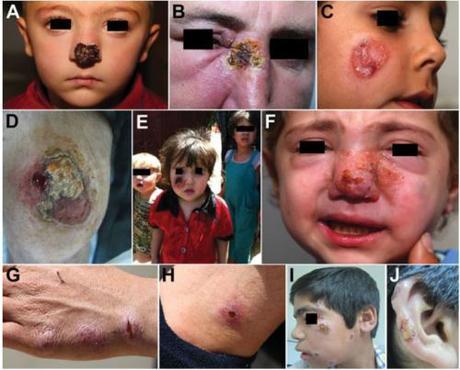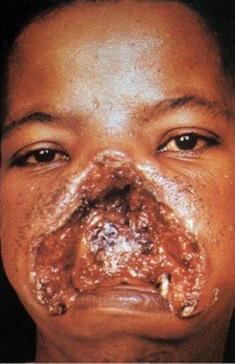Despite the fact that the FBI had admitted that they don’t have the database to vet Syrian “refugees” being brought to the U.S., on December 18, 2015, the traitorous Republican-majority Congress approved of the omnibus spending bill H.R. 2029 that fully funds the “refugee” program, as well as Planned Parenthood, climate change, and amnesty for illegals. (See “Betrayal: GOP funds Planned Parenthood, Syrian ‘refugees’ and amnesty for illegals“)
But the problem isn’t just that Muslim jihadists are among those “refugees”. It turns out that Syrian “refugees” are also bringing into this country a terrible flesh-eating disease called cutaneous leishmaniasis. In fact, the federal government’s Centers for Disease and Control (CDC) published an article about this more than a year ago.
In the October 2014 issue of the CDC’s EID Journal, an article titled “Ongoing Epidemic of Cutaneous Leishmaniasis among Syrian Refugees, Lebanon” says:
(Note: footnotes are omitted in the excerpts below; words colored green are mine)
Leishmaniasis is a parasitic disease comprising a wide spectrum of chronic infections in humans and in certain animal species…. Leishmaniasis is a major public health concern in the eastern Mediterranean region, which bears the brunt of the worldwide prevalence (≈57%), and is endemic to 16 of the 23 countries in this region, and Afghanistan, Iraq, and the Syrian Arab Republic are among the hot spots of leishmaniasis.
The 3 major forms of leishmaniasis (cutaneous, mucocutaneous, and visceral) are transmitted by the bite of the female sandfly…. Aleppo [the largest city in Syria] is one of the most cutaneous leishmaniasis–endemic areas in the world; ≈12,000 new cases occur each year. We have documented a cutaneous leishmaniasis outbreak among Syrian refugees within the Lebanese borders that began in September 2012 and is ongoing….
Most (77%) patients reported the appearance of the first lesion after being in Lebanon for >2 months [which means infected people are symptomless in the beginning stage!], and 53% of patients recalled history of an antecedent insect bite….
Fifty-nine percent of patients had >1 of the following: disease compromising the function of vital sensory organs (eye, ear, nose, and mouth) (27%); lesions >5 cm in diameter (49%); disfiguring facial lesions (37%); special forms, such as sporotrichoid or lymphangietic with satellite lesions (9%); and lesions present for >12 months’ duration (9%) [see Figure 2 below]

Figure 2. Patterns of leishmaniasis among Syrian refugees in Lebanon, 2012. A, B) Lesions impinging and possibly hindering the function of vital sensory organs, including the nose and eyes. C, D) Lesions >5 cm.E, F) Lesions disfiguring the face. G, H) Special forms of cutaneous leishmaniasis; shown here is a patient with spread and satellite lesions on the hand and arm. I, J) Patient with 15 lesions. (Source: CDC)
Aaron Klein reports for Breitbart, Dec. 20, 2015, that according to the peer-reviewed medical journal Pathogens, Lebanon had no cases of cutaneous leishmaniasis prior to 2008. After the arrival of refugees, however, 1,033 cases were confirmed by 2012, 96.6% (998) of which were among Syrian refugees.
Leishmaniasis has been spreading like wildfire in Syria since the health system collapsed in “rebel”-held territories in 2011. By 2012, there were already 52,982 documented cases of the disease in Syria.
An article in the UK’s Mirror of Dec. 4, 2015, reports that “health experts” say that ISIS or Islamic State militants are spreading leishmaniasis, “a flesh eating bug across war-torn Syria” as a result of their “slaughtering innocent people and dumping their bodies in the street.”
Breitbart continues:
Health agencies confirmed that Syrian refugees have transported leishmaniasis to Lebanon and Turkey, where it has been difficult to manage and treat.
Compounding the problem, patients can be infected with the parasitic disease without showing symptoms for weeks, months, or even years, and an asymptomatic patient most likely doesn’t know that he or she is a carrier.
This means the health screening process for refugees could miss the disease entirely….
Cutaneous [leishmaniasis] is the most common form among Syrians. It manifests in skin sores that typically develop within a few weeks or months of a sand fly bite. The sores can initially appear as bumps or nodules and may evolve into volcano-like ulcers.
Here’s a pic of a volcano-like cutaneous leishmaniasis ulcer (warning: gruesome!):

Mucocutaneous leishmaniasis causes skin ulcers like the cutaneous form, as well as mucosal ulcers that usually damage the nose and mouth.
Visceral leishmaniasis, which has also been found among Syrian refugees, is the most serious form and can be fatal. It damages internal organs, usually the spleen and liver, and also affects bone marrow.
For the names of the 150 Republicans in the House of Reps. who voted for HR 2029, the omnibus spending bill that fully funds the “resettlement” of Syrian “refugees” to the U.S., click here.
And if you still support the GOP by donating money and voting for this traitorous party, you are complicit in bringing leishmaniasis to America — a horrible disease that especially afflicts children.
Shame on you.
H/t FOTM reader GiGi
~Eowyn

